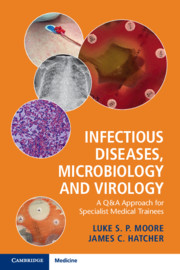Book contents
- Infectious Diseases, Microbiology and Virology
- Infectious Diseases, Microbiology and Virology
- Copyright page
- Contents
- Preface
- Reference Ranges
- Abbreviations
- Chapter 1 Biology of Bacteria, Viruses, Fungi and Parasites and the Host–Pathogen Interactions
- Chapter 2 Microbiology and Virology Laboratory Practice
- Chapter 3 Health and Safety for Infectious Diseases, Microbiology and Virology
- Chapter 4 Principles of Public Health in Relation to Infectious Diseases, Microbiology and Virology
- Chapter 5 Infection Prevention and Control
- Chapter 6 Important Clinical Syndromes Presenting from the Community and within Healthcare Organisations
- Chapter 7 Understanding the Use of Antimicrobial Agents
- Chapter 8 Vaccination
- Chapter 9 The Management of HIV Infection, Opportunistic Infections and Complications of Other Causes of Immunocompromise
- Chapter 10 Travel and Geographical Health; Imported Infection and the Provision of Pre-travel Health Advice
- Index
- References
Chapter 2 - Microbiology and Virology Laboratory Practice
Published online by Cambridge University Press: 19 December 2019
- Infectious Diseases, Microbiology and Virology
- Infectious Diseases, Microbiology and Virology
- Copyright page
- Contents
- Preface
- Reference Ranges
- Abbreviations
- Chapter 1 Biology of Bacteria, Viruses, Fungi and Parasites and the Host–Pathogen Interactions
- Chapter 2 Microbiology and Virology Laboratory Practice
- Chapter 3 Health and Safety for Infectious Diseases, Microbiology and Virology
- Chapter 4 Principles of Public Health in Relation to Infectious Diseases, Microbiology and Virology
- Chapter 5 Infection Prevention and Control
- Chapter 6 Important Clinical Syndromes Presenting from the Community and within Healthcare Organisations
- Chapter 7 Understanding the Use of Antimicrobial Agents
- Chapter 8 Vaccination
- Chapter 9 The Management of HIV Infection, Opportunistic Infections and Complications of Other Causes of Immunocompromise
- Chapter 10 Travel and Geographical Health; Imported Infection and the Provision of Pre-travel Health Advice
- Index
- References
Summary
To provide an effective infection specialist service, practitioners must be conversant in pre-analytical, analytical and post-analytical elements of laboratory practice, irrespective of the specific areas of infectious diseases undertaken on a day-to-day basis. Pre-analytical skills and knowledge will include areas such as understanding the microbial differential diagnoses sufficiently to advise on and obtain the correct tests on the optimal sample types, be this for culture or for serological or genetic diagnostic tests. Pre-analytical skills also help practitioners identify where tests will not aid diagnosis, including for conditions which are currently diagnosed clinically and for which laboratory diagnostics do not currently exist. Analytical skills and understanding will vary depending on the area of practice, but will include safe laboratory work, the strengths and limitations of different tests, the impact of quality assurance and quality control and the cost implications of different modalities. Post-analytical skills and understanding will include contextualisation of results in each patients’ care, awareness of positive and negative predictive values of different tests and implications for further diagnostics including reflex testing.
- Type
- Chapter
- Information
- Infectious Diseases, Microbiology and VirologyA Q&A Approach for Specialist Medical Trainees, pp. 24 - 59Publisher: Cambridge University PressPrint publication year: 2019

